INSTITUT SUPERIEUR D'ANTHROPOLOGIE
INSTITUTE OF ANTHROPOLOGY
ONLINE COURSES / COURS A DISTANCE
SPRING SESSION : APRIL 2013
REGISTER NOW
TURQUIE – 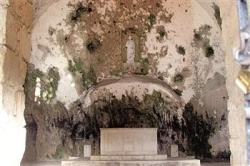 Habibi Neccar Mountain - The Church of St. Peter, which is the first cave church and regarded as a pilgrimage site for Christians in the eastern province of Hatay, will undergo restoration, and the rock on the church will be repaired. The church, which is located near the Habibi Neccar Mountain and known as a place where believers of Jesus secretly came together, is composed of a seven-meter-high and 13-meter-deep cave carved into rock.
Habibi Neccar Mountain - The Church of St. Peter, which is the first cave church and regarded as a pilgrimage site for Christians in the eastern province of Hatay, will undergo restoration, and the rock on the church will be repaired. The church, which is located near the Habibi Neccar Mountain and known as a place where believers of Jesus secretly came together, is composed of a seven-meter-high and 13-meter-deep cave carved into rock.
http://www.hurriyetdailynews.com/restoration-begins-at-worlds-first-cave-church.aspx?pageID=238&nid=44200
ISRAËL – 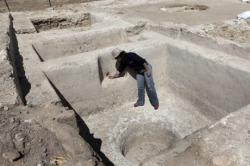 – Hamei Yo'av - Une lanterne vieille de 1500 ans décorée avec des croix et munie d'un pressoir a été découverte par des archéologues israéliens. La découverte archéologique, qui a été faite sur un site près de la ville d'Ashkelon, jette une nouvelle lumière sur la vie quotidienne de la période byzantine. L'archéologue Saar Ganor a expliqué que la lampe chrétienne revêtait une expérience particulière en raison de la rareté des vestiges archéologiques de ce genre. La lanterne a été sculptée d'une telle façon que des croix sont reflétées sur les murs d'une pièce lorsqu'une bougie l'éclaire. M. Ganor a ajouté que le pressoir était tout aussi particulier, en raison de sa grande taille. Le vin extrait à l'aide du pressoir était fréquemment exporté vers des pays de la Méditerranée, mais aussi en Europe et en Afrique du Nord.
– Hamei Yo'av - Une lanterne vieille de 1500 ans décorée avec des croix et munie d'un pressoir a été découverte par des archéologues israéliens. La découverte archéologique, qui a été faite sur un site près de la ville d'Ashkelon, jette une nouvelle lumière sur la vie quotidienne de la période byzantine. L'archéologue Saar Ganor a expliqué que la lampe chrétienne revêtait une expérience particulière en raison de la rareté des vestiges archéologiques de ce genre. La lanterne a été sculptée d'une telle façon que des croix sont reflétées sur les murs d'une pièce lorsqu'une bougie l'éclaire. M. Ganor a ajouté que le pressoir était tout aussi particulier, en raison de sa grande taille. Le vin extrait à l'aide du pressoir était fréquemment exporté vers des pays de la Méditerranée, mais aussi en Europe et en Afrique du Nord.
http://www.985fm.ca/international/nouvelles/israel-une-lanterne-de-1500-ans-a-ete-decouverte-229940.html
USA –  Springettsbury - The mud of a Pennsylvania cornfield may soon produce answers about the fate of British prisoners of war during the waning years of the American Revolution. A few miles east of York, the city that briefly served as the fledgling nation's capital after the Continental Congress fled Philadelphia, more than a thousand English, Scottish and Canadian soldiers were imprisoned at what was then known as Camp Security. A 1979 archaeological study found numerous artefacts that confirmed local lore about the prison camp's location. Nothing about the property today suggests it was once teeming with prisoners. The first group arrived in 1781, four years after their 1777 surrender at Saratoga, New York. More arrived the next year after the battle in Yorktown, Virginia, and in April 1782, there were 1,265 men at the camp, along with 182 women and 189 children - family members and others who accompanied the prisoners. The first group was kept under less strict conditions and could be hired out to nearby farms, where among other things they were put to use chopping firewood and hunting wolves. The Yorktown veterans were much more strictly confined, kept inside a circular stockade that had been constructed from 15ft-high log posts. The 1979 dig, which focused on a small area, produced metal items such as buckles and buttons that are associated with British soldiers of the period, suggesting that could have either been the Camp Security stockade or the adjacent Camp Indulgence village where low-risk prisoners stayed. That survey also turned up 20 coins and 605 straight pins that may have been used by prisoners to make lace.
Springettsbury - The mud of a Pennsylvania cornfield may soon produce answers about the fate of British prisoners of war during the waning years of the American Revolution. A few miles east of York, the city that briefly served as the fledgling nation's capital after the Continental Congress fled Philadelphia, more than a thousand English, Scottish and Canadian soldiers were imprisoned at what was then known as Camp Security. A 1979 archaeological study found numerous artefacts that confirmed local lore about the prison camp's location. Nothing about the property today suggests it was once teeming with prisoners. The first group arrived in 1781, four years after their 1777 surrender at Saratoga, New York. More arrived the next year after the battle in Yorktown, Virginia, and in April 1782, there were 1,265 men at the camp, along with 182 women and 189 children - family members and others who accompanied the prisoners. The first group was kept under less strict conditions and could be hired out to nearby farms, where among other things they were put to use chopping firewood and hunting wolves. The Yorktown veterans were much more strictly confined, kept inside a circular stockade that had been constructed from 15ft-high log posts. The 1979 dig, which focused on a small area, produced metal items such as buckles and buttons that are associated with British soldiers of the period, suggesting that could have either been the Camp Security stockade or the adjacent Camp Indulgence village where low-risk prisoners stayed. That survey also turned up 20 coins and 605 straight pins that may have been used by prisoners to make lace.
http://news.sky.com/story/1074842/cornfield-holds-secrets-of-1780s-british-pows
ROYAUME UNI – 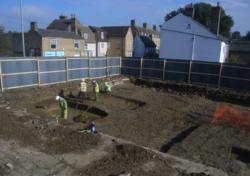 Huntingdon - Oxford Archaeology East is carrying out the dig in Ermine Street along the route of the forthcoming Huntingdon Town Centre link road on behalf of Cambridgeshire County Council and Huntingdonshire District Council. During the excavations, which will finish in early June, there will be a series of archaeology events held at Cromwell Museum, in Grammar School Walk, and Huntingdon Library, in Princes Street.:There will be an exhibition of the most recent finds on display at the museum from early April. Aileen Connor, senior project manager with Oxford Archaeology East said: “We’re really pleased that the Cromwell Museum and library are helping us bring to life this most recent dig into Huntingdon’s fascinating history. “This will be a great opportunity for the people of Huntingdon to see the finds and hear about the excavation almost as it is happening. We’re expecting lots of interesting finds from the Roman and medieval periods.”
Huntingdon - Oxford Archaeology East is carrying out the dig in Ermine Street along the route of the forthcoming Huntingdon Town Centre link road on behalf of Cambridgeshire County Council and Huntingdonshire District Council. During the excavations, which will finish in early June, there will be a series of archaeology events held at Cromwell Museum, in Grammar School Walk, and Huntingdon Library, in Princes Street.:There will be an exhibition of the most recent finds on display at the museum from early April. Aileen Connor, senior project manager with Oxford Archaeology East said: “We’re really pleased that the Cromwell Museum and library are helping us bring to life this most recent dig into Huntingdon’s fascinating history. “This will be a great opportunity for the people of Huntingdon to see the finds and hear about the excavation almost as it is happening. We’re expecting lots of interesting finds from the Roman and medieval periods.”
http://www.peterboroughtoday.co.uk/news/local/archeological-dig-begins-in-huntingdon-1-4971563
TURQUIE – 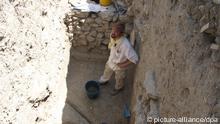 - For more than 100 years, German archaeologists have been carrying out excavations in Turkey to learn more about ancient civilizations. But now Turkey is threatening to rescind their permission to dig, saying that German researchers often leave behind a mess. Critics accuse Turkey of manufacturing a conflict in an attempt to force Germany to return legally acquired artifacts.
- For more than 100 years, German archaeologists have been carrying out excavations in Turkey to learn more about ancient civilizations. But now Turkey is threatening to rescind their permission to dig, saying that German researchers often leave behind a mess. Critics accuse Turkey of manufacturing a conflict in an attempt to force Germany to return legally acquired artifacts.
VIDEO = http://www.dw.de/arts21-the-cultural-magazine-2013-04-06/e-16669139-9798
TURQUIE – 
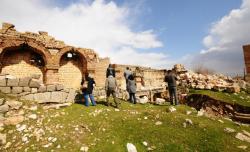 Anıtlı - The historic village of Anıtlı in the eastern province of Mardin’s Midyat, which was previously named Hah, is waiting to be discovered by the tourist industry for its breathtaking sights. Among the attractions in the village, Mor Sobo Cathedral, which served as the center of the Metropolitan community for nine centuries, and the Virgin Mary Church, which is located by a 2,000 year-old monument, captivate visitors to the region. Some sources reported that the church had been built in the first century A.D., he said, adding, “It is located around a two-millennia-old monument. It is the only one of its kind in the world. In the church, there is a dove figure depicting Jesus on the cross. This can be found only in the church here. We have not seen a figure similar to this in this region or in any other churches in the world. The central cathedral, known as Mor Sobo Church, had been a scientific center. Students from the Middle East went there for education. The head of Artuklu University archaeology department, Associate Professor Güner Coşkunsu, said they had organized expedition trips to the Anıtlı village, which had political, religious and cultural significance in Mardin and had been exceptionally preserved in the Tur Abdin region.
Anıtlı - The historic village of Anıtlı in the eastern province of Mardin’s Midyat, which was previously named Hah, is waiting to be discovered by the tourist industry for its breathtaking sights. Among the attractions in the village, Mor Sobo Cathedral, which served as the center of the Metropolitan community for nine centuries, and the Virgin Mary Church, which is located by a 2,000 year-old monument, captivate visitors to the region. Some sources reported that the church had been built in the first century A.D., he said, adding, “It is located around a two-millennia-old monument. It is the only one of its kind in the world. In the church, there is a dove figure depicting Jesus on the cross. This can be found only in the church here. We have not seen a figure similar to this in this region or in any other churches in the world. The central cathedral, known as Mor Sobo Church, had been a scientific center. Students from the Middle East went there for education. The head of Artuklu University archaeology department, Associate Professor Güner Coşkunsu, said they had organized expedition trips to the Anıtlı village, which had political, religious and cultural significance in Mardin and had been exceptionally preserved in the Tur Abdin region.
http://www.hurriyetdailynews.com/midyats-historic-village-seeks-recognition.aspx?pageID=238&nID=44334&NewsCatID=375
FRANCE – 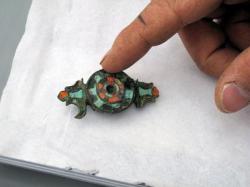 Charleville Mézières - La cellule archéologique départementale fera découvrir un chantier en cours de fouilles : un village artisanal du IIIe siècle. «Ce site de fouilles est exceptionnel car il met au jour un village artisanal en milieu rural où on produisait du laiton, ce qui est rare au IIIe siècle et où on peut voir (presque) toute la chaîne de production. » L'enthousiasme du responsable du site archéologique du clos Paul, Jérôme Marian, et du responsable de la cellule départemental d'archéologie, Olivier Brun, est communicatif. Au IIIe siècle, en pleine époque romaine, le village artisanal, a pour voisins les plus proches les habitants de Montcy-Saint-Pierre à deux kilomètres. Quatre familles y ont vraisemblablement travaillé de 240 à 280 après Jésus-Christ. « Ils étaient très organisés », remarque Jérôme Marian en montrant les drains créés à plusieurs endroits du site afin d'emmener l'eau dans un « fossé -collecteur ». Un premier diagnostic archéologique a été établi en 2007 sur cinq hectares. De jolies pièces ont déjà été découvertes : une fibule, un stylet, des pièces de céramique… Le chantier actuel permet de rêver quant aux découvertes à venir dans les semaines à venir. Trois unités de production ont été découvertes : la création du charbon, le stockage du charbon et enfin un four où le laiton était fondu dans des creusets. Le laiton partait-il en lingots ou bien était-il transformé sur place en petites pièces de métallurgie fine ? Cette dernière option rendrait le site encore plus exceptionnel. « La métallurgie très fine en laiton était peu utilisée à l'époque romaine. Il existe moins de cinq sites en France. » Et Olivier Brun de préciser encore : « C'est le début de la mise en place de la métallurgie dans la vallée de la Meuse ! »
Charleville Mézières - La cellule archéologique départementale fera découvrir un chantier en cours de fouilles : un village artisanal du IIIe siècle. «Ce site de fouilles est exceptionnel car il met au jour un village artisanal en milieu rural où on produisait du laiton, ce qui est rare au IIIe siècle et où on peut voir (presque) toute la chaîne de production. » L'enthousiasme du responsable du site archéologique du clos Paul, Jérôme Marian, et du responsable de la cellule départemental d'archéologie, Olivier Brun, est communicatif. Au IIIe siècle, en pleine époque romaine, le village artisanal, a pour voisins les plus proches les habitants de Montcy-Saint-Pierre à deux kilomètres. Quatre familles y ont vraisemblablement travaillé de 240 à 280 après Jésus-Christ. « Ils étaient très organisés », remarque Jérôme Marian en montrant les drains créés à plusieurs endroits du site afin d'emmener l'eau dans un « fossé -collecteur ». Un premier diagnostic archéologique a été établi en 2007 sur cinq hectares. De jolies pièces ont déjà été découvertes : une fibule, un stylet, des pièces de céramique… Le chantier actuel permet de rêver quant aux découvertes à venir dans les semaines à venir. Trois unités de production ont été découvertes : la création du charbon, le stockage du charbon et enfin un four où le laiton était fondu dans des creusets. Le laiton partait-il en lingots ou bien était-il transformé sur place en petites pièces de métallurgie fine ? Cette dernière option rendrait le site encore plus exceptionnel. « La métallurgie très fine en laiton était peu utilisée à l'époque romaine. Il existe moins de cinq sites en France. » Et Olivier Brun de préciser encore : « C'est le début de la mise en place de la métallurgie dans la vallée de la Meuse ! »
http://www.lunion.presse.fr/article/ardennes/les-fouilles-du-clos-paul-ouvertes-au-public